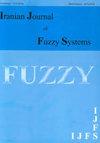(2009-6145) Multi-criteria decision making based on q-rung orthopair fuzzy promethee approach
IF 1.2
4区 数学
Q1 MATHEMATICS
引用次数: 2
Abstract
The preference ranking organization method for enrichment of evaluations (PROMETHEE) {constitutes a family of outranking} multiple-attribute decision-making (MADM) methods {that has been adopted by researchers from many areas during} the last years.It provides reliable and clear results {thanks to the} advantages of different types of preference functions.{In this paper, we incorporate the benefits of q-rung orthopair fuzzy set (for short, q-ROFS) in this strategy of solution.} {This model, q-ROFS, is a generalized form of Pythagorean fuzzy set (PFS)}, as it {broadens} the space of acceptable orthopairs and {has} an ability to deal with more elaborate and vague information. The technique of {our extension of the} PROMETHEE method {uses} q-rung orthopair fuzzy numbers to {render} the ratings of alternatives, {which allows us} to express {uncertain and vague information more accurately}.The usual criterion preference function {has} been used to measure the preferences of {the} alternatives.A partial ordering of alternatives is obtained by considering the outgoing and incoming flows of alternatives, which is known as PROMETHEE I.Furthermore, a complete ordering is accomplished by taking into account the procedure of PROMETHEE II.As a numerical {exercise, we consider the selection of a contractor for a construction project}.{A full analysis} is performed {to illustrate the application of the technique that stems from our approach}.{Then we compare the results that we obtain with the results from existing approaches, including q-rung orthopair fuzzy ELECTRE, q-rung orthopair fuzzy TOPSIS, q-rung orthopair fuzzy VIKOR and q-rung orthopair fuzzy aggregation operators.In this way the accuracy and effectiveness of the presented work is conclusively validated[j] .基于q阶正形模糊算法的多准则决策
用于丰富评价的偏好排序组织方法(PROMETHEE){构成了一个多属性决策(MADM)方法家族{已被许多领域的研究人员在过去几年中采用。由于不同类型的偏好函数的优势,它提供了可靠和清晰的结果。在本文中,我们将q-rung正形模糊集(简称q-ROFS)的优点纳入到该求解策略中。{这个模型,q-ROFS,是一种广义的毕达哥拉斯模糊集(PFS)},因为它{拓宽了}可接受的正形空间,并且{具有}处理更复杂和模糊信息的能力。我们对PROMETHEE方法的扩展技术{使用}q-rung正形模糊数{呈现}选项的评级,{这使我们}能够更准确地表达{不确定和模糊的信息}。通常的标准偏好函数{已}被用来衡量{的}选项的偏好。通过考虑备选方案的进出流,得到备选方案的部分排序,称为PROMETHEE i。通过考虑PROMETHEE II的过程,得到备选方案的完全排序。作为一个数值{练习,我们考虑一个建筑项目承包商的选择}。{一个完整的分析}被执行{说明技术的应用,源于我们的方法}。{然后我们将得到的结果与现有方法的结果进行比较,包括q-rung正形模糊ELECTRE、q-rung正形模糊TOPSIS、q-rung正形模糊VIKOR和q-rung正形模糊聚合算子。通过这种方式,所提出的工作的准确性和有效性得到了最终的验证
本文章由计算机程序翻译,如有差异,请以英文原文为准。
求助全文
约1分钟内获得全文
求助全文
来源期刊
CiteScore
3.50
自引率
16.70%
发文量
0
期刊介绍:
The two-monthly Iranian Journal of Fuzzy Systems (IJFS) aims to provide an international forum for refereed original research works in the theory and applications of fuzzy sets and systems in the areas of foundations, pure mathematics, artificial intelligence, control, robotics, data analysis, data mining, decision making, finance and management, information systems, operations research, pattern recognition and image processing, soft computing and uncertainty modeling.
Manuscripts submitted to the IJFS must be original unpublished work and should not be in consideration for publication elsewhere.

 求助内容:
求助内容: 应助结果提醒方式:
应助结果提醒方式:


